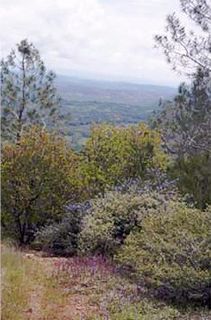
Iris douglasiana, the Douglas iris, is a common wildflower of the coastal regions of Northern and Central California and southern Oregon in the United States. The Douglas Iris was first described by 19th century botanist David Douglas in Monterey, California. It grows mainly at lower elevations, below 100 meters (330 ft), though it is occasionally found at heights of up to 1,000 meters (3,300 ft). It is most common in grasslands near the coast; it is regarded as a noxious weed in pastures, because it forms clumps that inhibit other vegetation, and its leaves are bitter and unpalatable to cattle.

Iris series Californicae are a series of the genus Iris, in Iris subg. Limniris. They are commonly known as Pacific Coast iris (PCI), or Pacific Coast natives (PCN).

Lilium humboldtii is a species of lily native to the US state of California and the Mexican state of Baja California. It is named after naturalist and explorer Alexander von Humboldt. It is native to the South High Cascade Range, High Sierra Nevada, south Outer South Coast Ranges, and the Santa Monica Mountains and others in Southern California, growing at elevations from 600 metres (2,000 ft) to 1,200 metres (3,900 ft).

Iris pseudacorus, the yellow flag, yellow iris, or water flag, is a species of flowering plant in the family Iridaceae. It is native to Europe, western Asia and northwest Africa. Its specific epithet pseudacorus means "false acorus", referring to the similarity of its leaves to those of Acorus calamus, as they have a prominently veined mid-rib and sword-like shape. However, the two plants are not closely related.

Iris lacustris, the dwarf lake iris, is a plant species in the genus Iris, subgenus Limniris and in the section Lophiris. It is a rhizomatous, beardless perennial plant, native to the Great Lakes region of eastern North America. It has lavender blue or violet-blue flowers, a very short stem and long fan-like green leaves. It is cultivated as an ornamental plant in temperate regions. It is closely related to Iris cristata.

Iris purdyi is a species of iris known by the common name Purdy's iris, named after Carl Purdy. It is found in the redwood forests of California and into southern Oregon, and hence is also known as the redwood iris. The plant flowers from April to June.

Fritillaria striata, known by the common name striped adobe lily, is an uncommon species of fritillary.

Dudleya brevifolia, is a rare succulent plant known by the common name short-leaved liveforever or short-leaved dudleya. It was formerly a subspecies of Dudleya blochmaniae.

Enceliopsis covillei, known by the common name Panamint daisy, is a rare North American desert species of flowering plant in the daisy family.

Pine Hill Ecological Reserve is a nature reserve of 403 acres (1.63 km2) located due east of Folsom Lake in the Sierra Nevada foothills, in El Dorado County, California. The reserve was established in 1979, and is managed by the California Department of Fish and Game.
Navarretia rosulata is a rare species of flowering plant in the phlox family known by the common names San Anselmo navarretia, Marin County navarretia, and Marin County pincushionplant.
Platanthera cooperi is an uncommon species of orchid known by the common names Cooper's rein orchid and chaparral rein orchid.
Plagiobothrys parishii, known by the common name Parish's popcornflower, is an uncommon species of flowering plant in the borage family.

Sidalcea oregana is a species of flowering plant in the mallow family known by the common name Oregon checkerbloom.

Sidalcea robusta is an uncommon species of flowering plant in the mallow family known by the common name Butte County checkerbloom.
Trifolium bolanderi is a species of clover known by the common names Bolander's clover and parasol clover.
Iris odaesanensis is a beardless iris in the genus Iris, in the subgenus Limniris and in the series Chinenses of the genus. It is a rhizomatous herbaceous perennial from China and eastern Korea. It has blue-green grass-like leaves, short stem, 1 or 2 fragrant, white or off-white flowers in spring to early summer. It is a rare plant in the wild, but it is cultivated in east Asia.

The CNPS Inventory of Rare and Endangered Plants of California is a botanical online database providing information on rare, threatened, and endangered California native plants. It is sponsored by the California Native Plant Society (CNPS).

Iris mariae is a species in the genus Iris, it is also in the subgenus Iris and in the section Oncocyclus. t is a rhizomatous perennial, from the deserts of Israel and Egypt. It is fairly tall, with long and slender glaucous leaves, and in late spring, lilac-purple to pinkish or violet flowers with deeper veining and blackish-violet signal and dark purple beard.
Iris westii is a species in the genus Iris, it is also in the subgenus of Iris and in the Oncocyclus section. It is from the mountain sides of Lebanon. It has curved grey-green leaves, a stem carrying one flower in shades of lilac, white or beige with spotting or veins in a darker shade or violet. The lower petals have deep velvety chocolate or deep violet-black signal patch and a purple beard. It rare and threatened due to habitat destruction, from military actions, overgrazing by goats and other factors.














